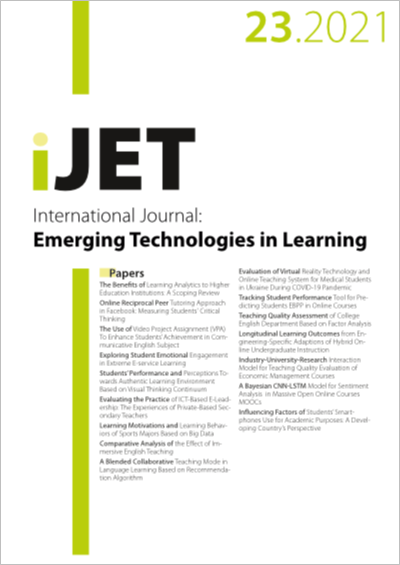Evaluation of Virtual Reality Technology and Online Teaching System for Medical Students in Ukraine During COVID-19 Pandemic
DOI:
https://doi.org/10.3991/ijet.v16i23.26099Keywords:
Virtual reality technology, online teaching system, medical educationAbstract
A study has been conducted to evaluate the virtual reality technology and online teaching system among medical students of Bogomolets National Medical University, Ukraine during COVID-19 pandemic. The final questionnaire contained the 15 questions with 5 options to comprehensively evaluate the virtual reality technology and online teaching system. The feedback of the survey was analyzed to find effectiveness of virtual reality technology and online teaching in medical education in Ukraine. Data of survey reflected that mostly students adopted and agreed on virtual reality technology and online teaching and admitted that these technologies are best alternatives to physical learning with the 65.79% an agreement with the user-friendly interface for virtual reality and online teaching system, while, 64.03% showed an agreement that virtual reality and online teaching system compensated the suspension of face-to-face medical education during the COVID-19. During online learning, there was ample time for educational activities as depicted from their response of 36.84% as strongly agree, 35.96% as agree, 6.14% as disagree, 4.39% as strongly disagree and 16.67% as neither agree nor disagree. Tutors/teachers also enjoyed virtual reality and online learning through their experience and flexibility in time management. Likewise, the results of all questions showed positive reviews and encouraged virtual reality and online teaching in academic continuity and stability in medical education in Ukraine. It can be concluded that digital learning environments are extremely effective in terms of medical students and staff satisfaction, accomplishment, and technical learning skill growth.
Downloads
Published
2021-12-08
How to Cite
Tsekhmister, Y. V., Konovalova, T., Tsekhmister, B. Y., Agrawal, A., & Ghosh, D. (2021). Evaluation of Virtual Reality Technology and Online Teaching System for Medical Students in Ukraine During COVID-19 Pandemic. International Journal of Emerging Technologies in Learning (iJET), 16(23), pp. 127–139. https://doi.org/10.3991/ijet.v16i23.26099
Issue
Section
Papers
License
Copyright (c) 2021 Bogdan Tsekhmister, Amit Agrawal, Dipanjana Ghosh

This work is licensed under a Creative Commons Attribution 4.0 International License.



